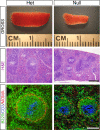Impaired Cellular Immunity in the Murine Neural Crest Conditional Deletion of Endothelin Receptor-B Model of Hirschsprung's Disease
- PMID: 26061883
- PMCID: PMC4465674
- DOI: 10.1371/journal.pone.0128822
Impaired Cellular Immunity in the Murine Neural Crest Conditional Deletion of Endothelin Receptor-B Model of Hirschsprung's Disease
Abstract
Hirschsprung's disease (HSCR) is characterized by aganglionosis from failure of neural crest cell (NCC) migration to the distal hindgut. Up to 40% of HSCR patients suffer Hirschsprung's-associated enterocolitis (HAEC), with an incidence that is unchanged from the pre-operative to the post-operative state. Recent reports indicate that signaling pathways involved in NCC migration may also be involved in the development of secondary lymphoid organs. We hypothesize that gastrointestinal (GI) mucosal immune defects occur in HSCR that may contribute to enterocolitis. EdnrB was deleted from the neural crest (EdnrBNCC-/-) resulting in mutants with defective NCC migration, distal colonic aganglionosis and the development of enterocolitis. The mucosal immune apparatus of these mice was interrogated at post-natal day (P) 21-24, prior to histological signs of enterocolitis. We found that EdnrBNCC-/- display lymphopenia of their Peyer's Patches, the major inductive site of GI mucosal immunity. EdnrBNCC-/- Peyer's Patches demonstrate decreased B-lymphocytes, specifically IgM+IgDhi (Mature) B-lymphocytes, which are normally activated and produce IgA following antigen presentation. EdnrBNCC-/- animals demonstrate decreased small intestinal secretory IgA, but unchanged nasal and bronchial airway secretory IgA, indicating a gut-specific defect in IgA production or secretion. In the spleen, which is the primary source of IgA-producing Mature B-lymphocytes, EdnrBNCC-/- animals display decreased B-lymphocytes, but an increase in Mature B-lymphocytes. EdnrBNCC-/- spleens are also small and show altered architecture, with decreased red pulp and a paucity of B-lymphocytes in the germinal centers and marginal zone. Taken together, these findings suggest impaired GI mucosal immunity in EdnrBNCC-/- animals, with the spleen as a potential site of the defect. These findings build upon the growing body of literature that suggests that intestinal defects in HSCR are not restricted to the aganglionic colon but extend proximally, even into the ganglionated small intestine and immune cells.
Conflict of interest statement
Figures







References
Publication types
MeSH terms
Substances
Grants and funding
LinkOut - more resources
Full Text Sources
Other Literature Sources
Molecular Biology Databases
Miscellaneous

